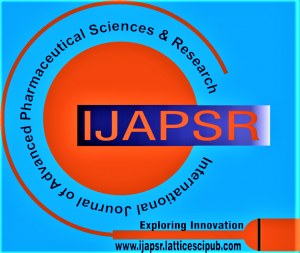![]()
A Review: Nanoparticles for Drug Delivery Design, Development & Therapeutic Application
Mahek M. Shaikh1, Ajit B. Tuwar2, Megha T. Salve3
1Mahek M. Shaikh, Department of Pharmacy, Shivajirao Pawar College of Pharmacy, Pachegaon (Maharashtra), India.
2Ajit B. Tuwar, Department of Pharmacy, Shivajirao Pawar College of Pharmacy, Pachegaon (Maharashtra), India.
3Dr. Megha T. Salve, Department of Pharmacy, Shivajirao Pawar College of Pharmacy, Pachegaon (Maharashtra), India.
Manuscript received on 29 November 2024 | First Revised Manuscript received on 09 December 2024 | Second Revised Manuscript received on 28 January 2025 | Manuscript Accepted on 15 February 2025 | Manuscript published on 28 February 2025 | PP: 5-9 | Volume-5 Issue-2, February 2025 | Retrieval Number: 100.1/ijapsr.A406505011224 | DOI: 10.54105/ijapsr.A4065.05020225
Open Access | Editorial and Publishing Policies | Cite | Zenodo | OJS | Indexing and Abstracting
© The Authors. Published by Lattice Science Publication (LSP). This is an open-access article under the CC-BY-NC-ND license (http://creativecommons.org/licenses/by-nc-nd/4.0/)
Abstract: Nanoscience is now used in many clinical and medical domains, including the treatment of cancer. On the other hand, there are many people who suffer from cancer and its variants, which have been rumored to be inclusive. In actuality, despite the therapeutic impact, patients have uncomfortable side effects from modern treatment procedures like chemotherapy, radiation, etc. To address this serious sickness, researchers and scientists are also trying to develop and improve treatment alternatives and approaches. These days, nanotechnology and nanoscience are widely used. Their various fields, such as nanoparticles, are frequently employed for a variety of purposes, particularly in imaging and drug delivery as well as diagnostic devices. The release of cancer is significantly impacted by release mechanisms centered on nanotechnology [1]. The precision medicine age has led to bottlenecks in traditional medications, including decreased solubility, absorption, and particularly ineffective organ or cell targeting. To address the aforementioned flaws, it is critically necessary to find and implement new techniques or tactics to alter existing medications or develop new ones. Although there are still numerous shortcomings, the solubility, absorption, and targeting of conventional medications have been significantly enhanced with the use of nanotechnology through the modification and fabrication of different kinds of nanoparticles [2].
Keywords: Drug Delivery; Nanomedicine; Nanoparticles; Personalized Medicine, Nanocarriers.
Scope of the Article: Pharmaceutical Technology
